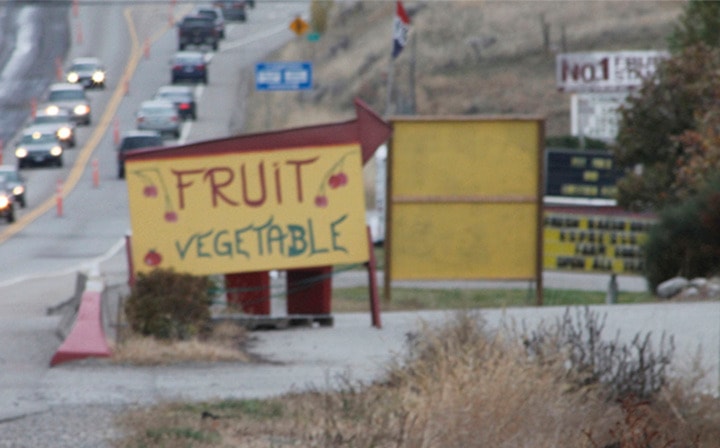Unauthorized signs that have sprung up along Highway 97 in the South Okanagan are now in the crosshairs of government officials, who will adopt a “scorched-earth” approach to cleaning up the mess early next year.
Staff from the Regional District of Okanagan-Similkameen have teamed with counterparts from the B.C. Transportation Ministry for a pilot project that will clear a 10-kilometre stretch of the highway corridor between Road 1 and Road 21 south of Oliver where a recent count tallied 140 signs.
“It’s a driver distraction,” said Jeff Wiseman, a regional manager for the ministry, who last week shared details of the project with the RDOS board, which requested action last year.
He said signs on that particular stretch of roadway “have proliferated to the extent now that just the sheer number of signs has become a safety issue.”
Besides limiting visibility, Wiseman explained, the unauthorized signs also distract from official notices that indicate speed limits or upcoming hazards.
While some signs are sanctioned, such as the small, blue-and-white metal placards that advertise a business, the majority are not, he continued, since “we permit very little, if nothing,” while those on private property are subject to a narrow set of RDOS bylaws that most don’t follow.
Wiseman said the pilot project will begin in January, when property owners in the targeted area will receive letters asking them to remove their illicit signs. After a month, those who don’t comply will be given another 30 days, after which signs that remain in place will be removed by the ministry’s highway maintenance contractor.
He noted the contractor is obligated to do so at no extra charge under its existing deal, and that working in concert with the RDOS will help prevent people from simply moving non-conforming signs off of highway right-of-ways and onto private property.
Wiseman was asked to explain why the ministry allowed the population of signs to explode in the first place, which he attributed to a lack of resources and the absence of consistent divisions between private and public property.
Plus, “In the past, we’ve been a little bit sometimes reluctant to go after these signs with great gusto because if you go after one, generally you have to go after them all. You can’t single one out,” he explained.
Summerland Mayor Janice Perrino expressed concern that the pilot project hadn’t been communicated very well to the general public, members of which could currently be investing in new signage that will later be torn down.
“I just think the communication system needs to be improved on this one to let the public know what’s happening,” said Perrino, also an RDOS director.
Tom Styffe, the alternate director for Okanagan Falls-Kaleden, said the RDOS needs to do more homework in areas where tearing down iconic signs, like those belonging to Tickleberry’s or the Bear’s Fruit Stand near Keremeos, might generate public backlash.
“There will be some controversy,” Styffe said.
RDOS chief administrative officer Bill Newell warned, however, that the aim of the project is to get rid of every sign that doesn’t follow the letter of the law.
“Unless it’s legally there, I don’t think we’re going to be looking at grandfathering” existing signs, Newell said. “This is scorched-earth.”
